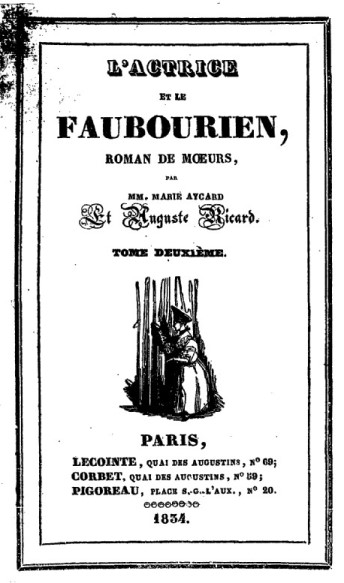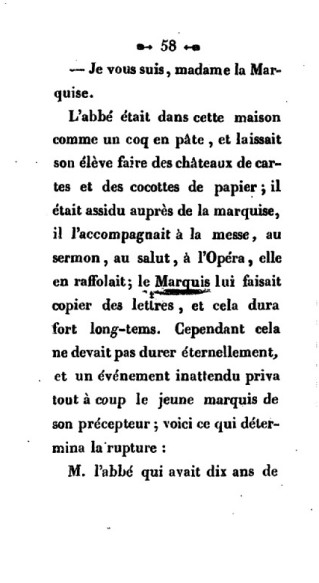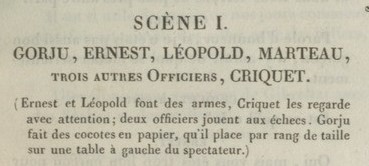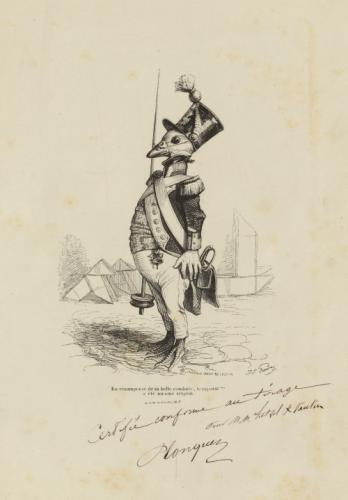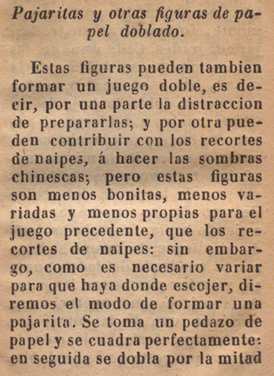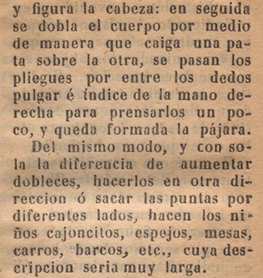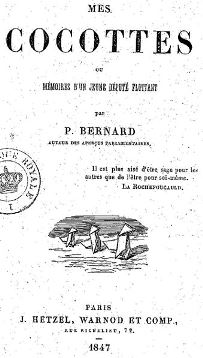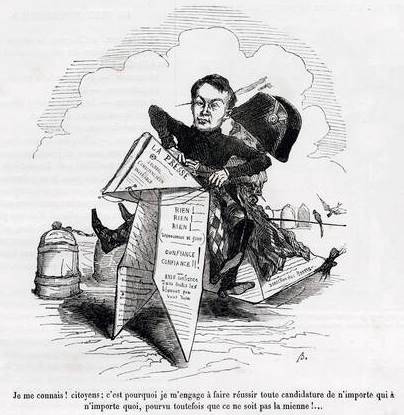| The Public Paperfolding History Project
Last updated 19/8/2025 x |
|||||||
| The Cocotte / Pajarita in Europe 1800 to 1849 | |||||||
This page is being used to collect information about the history of the traditional paperfolding design known as the Cocotte (in French) and the Pajarita (in Spanish) in Europe during the years 1800 to 1849. Please contact me if you know any of the information on this page is incorrect or if you have any other important information that should be added. Thank you. There are separate pages about the history of the Cocotte / Pajarita in Europe: ********** Introduction Like many other traditional paperfolds the Cocotte / Pajarita design is probably much older than the evidence for its existence, though just how much older, it is, of course, impossible to say. The Cocotte / Pajarita design has other names, often several other names, in other languages. Some of these names interpret the design as a bird, others as a horse and some as another creature entirely such as a grasshopper or dragon. As far as I know the Cocotte / Pajarita design has no settled name in Italian. In German the oldest name seems to be Krahe, but others, such as Drachen, also exist. In English the name Hobby Horse has been used since 1948 (see entry for that year) but probably not before that date. In French the word Cocotte can also refer to a hen, a casserole dish, a paperfold in general, or a prostitute. Consequently, the word should not be interpreted as referring to this specific paperfold without adequate contextual support. In Spanish the word Pajarita can also bear a wide range of meanings and the same necessity for having adequate contextual support applies. Even when it refers to a paperfold it does not always refer to the Cocotte / Pajarita design. For instance, in 'Guia Practica del Trabajo Manual Educativo' by Ezequiel Solana, which was published by Editorial Magisterio Español in Madrid in 1904, the Flapping Bird is called the 'Pajarita de Movimiento' and in 'El Mundo de Papel' by Dr Nemesio Montero, which was published by G Miranda in Edicions Infancia in Valladolid in 1939, the Flapping Bird is referred to as 'Pajarita que mueve las alas'. Spanish publications also refer to the Cocotte / Pajarita as a palomita (dove) or a gallito (cock). There is a separate page about Le Moineau, a version of the Cocotte / Pajarita design developed into a sparrow. It is noteworthy that many of the illustrations on this page picture Cocottes which are anatomically incorrect in one way or another. I have no idea why this should be the case. It is also noteworthy that although Cocotte means 'hen' and Pajarita 'little bird' many of the illustrations on this page show Cocottes / Pajaritas being ridden like horses. As far as I know no academic study has been conducted into the symbolism of the Cocotte / Pajarita in French, Spanish and Italian satirical magazines. Such a study seems long overdue. There are many other images of Cocottes / Pajaritas which cannot be dated precisely and cannot therefore be accurately slotted into the chronology on thee pages.. ********** Chronology There are three references to paper birds in 18th Century literature which are possibly, although not provably, references to the Cocotte / Pajarita. These references can be found on the page about Paper Birds. ********** 1801 As far as I know the earliest indisputable evidence for the existence of the Cocotte is a painting by Jeanne-Elisabeth Chaudet-Husson (1767 to 1832) entitled 'Un enfant qui montre les images d’un livre' which was exhibited at the Paris salon of 1801 (no 64). Information from José Tomas Buitrago and Wikimedia Commons.
********** 1806 There is another painting by the same artist, titled 'Marie-Laetitia Murat portant le buste de Napolean', which also shows a Cocotte, as well as a fold and cut Playing Card Monk, and which can be dated to 1806.
********** 1812 In his book 'Jugenderinnerungen eines altes Mannes' (Youth Memoirs of an Old Man), published by Wilhelm Herz Verlag Berlin in 1870, Wilhelm von Kügelgen describes how, in about 1812, when the family were living in Dresden, his then tutor, the painter Carl Adolf Senff (1785-1863), taught him, together with his siblings Gerhard and Adelheid, and the Leipzig friends Alfred and Julius Volksmann, to fold Krahen (crows). It is clear from the description that these were Cocottes / Pajaritas. The children learned to add further folds to develop these crows into Ross und Reiter (Horses and Riders), some of which still survive in museums in Germany.
In English, very roughly, and with the omission of difficult parts, 'The most enjoyable thing that Senff taught us was the art of folding certain small triangular shapes, otherwise known as 'crows', out of paper, but when they were made, the last fold was so difficult that it could not be taught … We used to leave this accomplishment to the old master Senff for quite some time until we finally got to grips with it one by one.' It is not clear where Senff might have learned to fold Cocotte / Pajaritas, since there is no other evidence for this design in Germany at this date. There is no evidence that he had, for instance, spent time in France. ********** 1820 There is mention of 'rampant little paper game-cocks', which may be a description of Cocottes, in Part 6 of 'The Sketch Book of Geoffrey Crayon, Gent' by Washington Irving, which was published by C S Van Winkle in New York in 1820.
********** 1821 There are several mentions of cocottes en papier in 'Les Paratonnerres' by MM B d'Aubigny et Boirie, a comedy first performed in Paris in 1921.
********** 1827 'Manuel Complet des Jeux de Société' by Elisabeth Celnart, which was published by La Librairie Encyclopedique de Roret in Paris in 1827, contains instructions, but no illustration, explaining how to fold 'les oiseaux' by blintzing a square three times and pulling out the folds. The instructions appear to explain how to make a Cocotte / Pajarita (the version that would now be folded from a blintzed windmill base), except that no mention is made of the necessity to reverse fold the head.
********** 1832 A Cocotte also appears in this drawing from 'La Caricature', No 63 of 12 January 1832 entitled 'Les Armes du Grand Poulot'.
The publication of this drawing, along with an article and another drawing from the same issue, was the basis of a prosecution brought against the editor of La Caricature, Charles Philipon. Full details are here. ********** The issue of the 'Courrier du Midi' newspaper for 31st March 1832 contained the following paragraph 'Le feu Roi de Sardaigne. Il faisait des cocottes de papier; il en avait un régiment de plus de cinq mille, toutes exécutées par lui ; il les aimait autant qu'il aimait son régiment des gardes.' (The late King of Sardinia. He made cocottes of paper; he had a regiment of more than five thousand, all executed by him; he loved them as much as he loved his regiment of guards.)
********** A print by Grandville published in the French magazine 'La Caricature' no 109 of 6 December 1832, which can be found online at https://gallica.bnf.fr/ark:/12148/bpt6k1048946v/f1.item, shows six Cocottes standing on top of the central monument. My thanks to Juan Gimeno for this information.
********** The following week's edition of 'La Caricature', no 110 dated 13th December 1832, which can be found online at https://gallica.bnf.fr/ark:/12148/bpt6k1048948p.item, also contained a cartoon by Grandville showing Cocottes. They are of varying sizes, apparently advancing to attack a toy village. My thanks to Jaume Coll Guerrero for this information.
A drawing taken from this cartoon, along with a detailed explanation of the identity of each figure and their meaning, appears in 'Histoire des Jouets' by Henry Rene D'Allemagne which was published by Librairie Hachette in Paris in 1902. (Information from Juan Gimeno)
********** 1833 This cartoon of Prosper Enfantin by Michael Delaporte appeared in issue 8 of the French satirical magazine 'La Charge' in 1833.
********** 1834 The second volume of 'L'actrice et le faubourien' by MM Marie Aycard (1794 -1859) and Auguste Ricard (1799 -1841), which was published by Lecointe, Corbet and Pigoreau in Paris in 1834 contains the words ' laissait son élève faire des châteaux de cartes et des cocottes de papier' (allowed his pupil to make card castles and paper cocottes'.
********** 1837 The issue of 'Figaro' for 23rd April 1937 contained an article headed 'SEANCES DE L'INSTITUT HISTORIQUE' of which the first paragraph partly reads 'Qu'est-ce que c'est que l'institut historique? C'est un institut comme un autre. On n'y fait rien, on n'y sert à rien ... on y fait des capucins de cartes et des cocottes en papier ...' (What is the Historical Institute? It is an institute like any other. Nothing is done there, there is no use for anything ... we make capucins de cartes and cocottes en papier ...)
********** 1838 The play 'Mademoiselle d'Aloigny, lieutenant de dragons' by M. Jacques Arago, which was premiered in Paris at the Vaudeville theatre on May 5th 1838 contains several references to cocottes, all folded by / associated with the character 'Gorju, capitaine de dragons'.
(Gorju makes paper cocottes, which he places in a row by size on a table to the left of the spectator.) ********** 1839 'Le Charivari' of 20th June 1839 contains the following description of a schoolboy: 'Il excella tellement dans chacun de ces exercices qu’il revint en vacances chargé d’un grand nombre de cocottes en papier, mais d’aucun prix d’honneur.' (He excelled so much in each of these exercises that he returned on vacation laden with a large number of cocottes de papier, but no prizes.'
********** 1841 Another drawing by Grandville, from his series 'albums de la vie privée et publique des animaux dessinés' and which can therefore be dated to either 1841 or 1842, shows two Cocottes and a Boat with Sail. From the collection of Paris Musees.
********** 1842 'Memoires de deux jeunes mariees' by Honore de Balzac, which was published in 1842, included the words 'Peut-etre Armand en fera-t-il des cocottes pour sa regiments alignes sur mes tapis ou des vaisseaux pour des flottes qui voguent sur son bain' (Perhaps Armand will make them into cocottes for his regiments lined up on my carpets or vessels for the fleets sailing in his bath).
********** 1845 'Petites miseres de la vie conjugale' by Honore de Balzac was published in Paris in 1845. It contains a passage mentioning cocottes which, roughly translated, reads: 'he uses for his cocottes the newspaper which you have not yet read.'
********** 1847 'Juegos de los Ninos' which was published in Madrid by R y Fonseca in 1847, contains a section headed 'Pajaritas y otras figuras de papel doblado' which describes how to fold a Pajarita. There is no accompanying illustration. These instructions clearly depend on similar instructions in 'Manuel Complet des Jeux de Société' by Elisabeth Celnart, which was published in Paris in 1827 (see above). This is the earliest clear reference that I know of to the Cocotte / Pajarita design in Spain.
********** 'Mes Cocottes ou Memoires d'un Jeune Depute Flottant' was published in Paris in 1847. Three Cocottes appear on the title page but there are only two references to Cocottes in the text, on pages 16 and 38.
Page 16
Page 38
********** 1848 This Caricature of Napoleon III by Bertall (1820-1882) was published in the 'Revue comique a l'usage des gens serieux' of December 1848.
********** |
|||||||
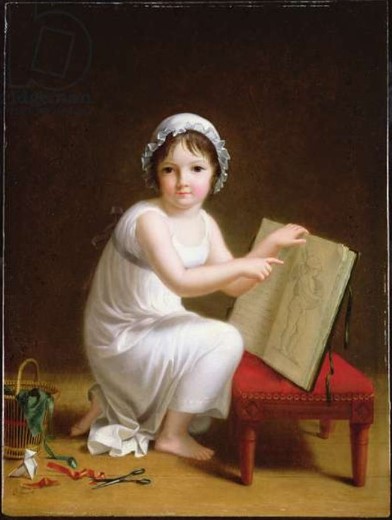
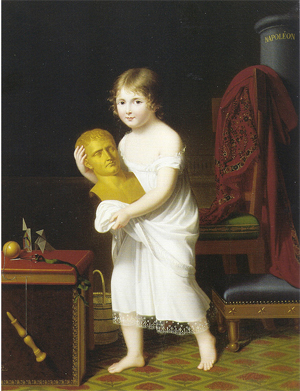
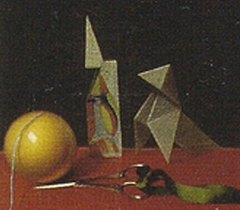



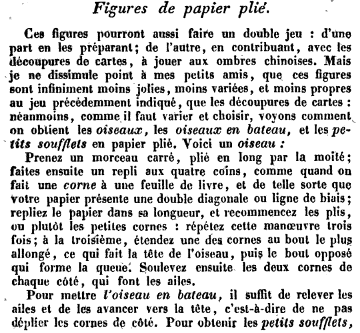
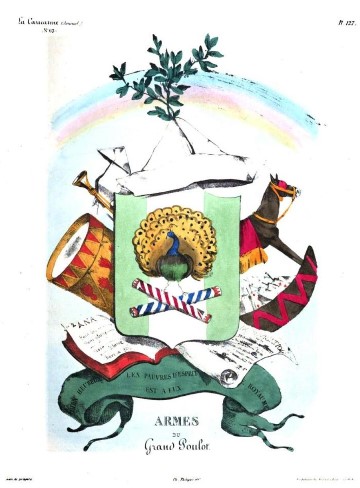
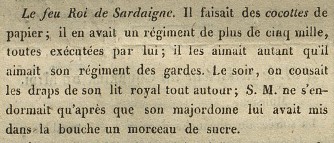
.jpg)
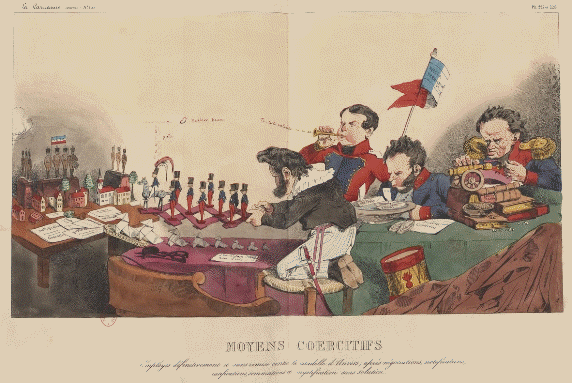
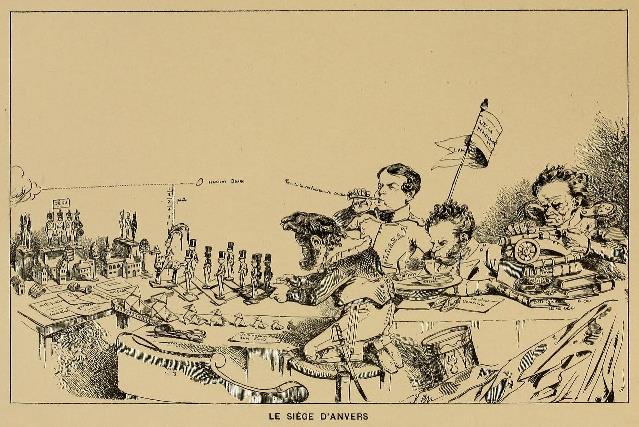
%201833.jpg)
